Interface Electronics05 DAC ArchitecturesProf. Dr. Jörg Vollrath04 Spectral Test |
Video Lecture: DAC architectures
|
Länge: 01:06:27 |
0:00:00 Laboratory specify your .raw file directory 0:03:29 Internet copyright form 0:04:18 Laboratory 3 start 0:07:28 DAC Architecture 0:08:02 DAC Performance 0:10:51 DAC Speed voltage difference requirements 0:16:36 RC Low pass thermal noise and LSB 0:20:15 Minimum C requirement C > 12 k T 22B/VFS2 0:21:26 Maximum speed R requirement 0:23:13 RC Low pass thermal noise capacitance requirement 0:25:26 Capacitance and white noise 0:26:45 3 bit R string or ladder DAC 0:29:50 Code 011 output voltage 0:32:38 Trnasfer curve calculation 0:33:32 Speed, power, numbe rof bits, complexity 0:36:13 Power 0:39:00 Interpolating R-string DAC 0:45:39 R2R DAC 0:48:21 Equivalent voltage source 0:50:36 2nd stage D1 0:55:10 DAC in Webreport for laboratory 2 0:57:27 |
Review and Overview
- Performance
- DAC architectures
- R string DAC
- Interpolating DAC
- Parallel charge scaling DAC
- Equivalent sources
- Split array charge scaling DAC
- Realization of capacitances
- R2R DAC
- Example: R-string DAC
- Statistical errors: INL and DNL
Performance
Go from one voltage level to another between certain sampling times.At the moment we assume an ideal sample and hold circuit. Real sample and hold circuits are presented later.
A simple RC charging circuit is our model.
Performance parameters are:
- Speed: Sampling rate, bandwidth, latency
- Power
- Number of bits
- Complexity
DAC speed: voltage difference requirement
|
A capacitor has to be charged to the 1/2 LSB range of the input voltage: \( | V_e - V_a | < 0.5 LSB \) The voltage on the capacitor is: \( V_a = V_e \cdot \left( 1 - e^{-\frac{t}{\tau}} \right) \) with \( \tau = RC \) Maximum difference could be full scale \( V_e = 2^{B} \cdot LSB \) with B number of bits: \( 2^{B} \cdot LSB \cdot e^{-\frac{t}{\tau}} < 0.5 LSB \) \( -\frac{t}{\tau} < \left( -B-1 \right) ln \left( 2 \right) \) \( t > R C \left( B+1 \right) ln \left( 2 \right) \) |
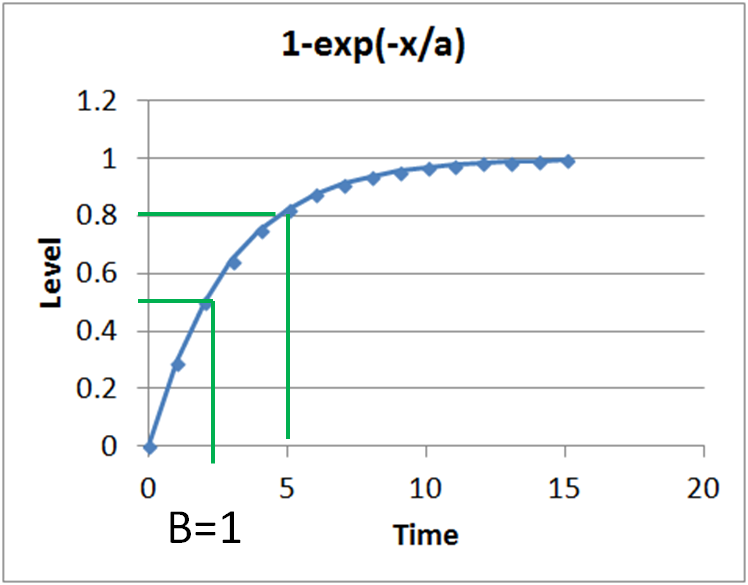
|
Settling time: (B+1)*t1
A capacitor has to be charged to the 1/2 LSB range of the input voltage:
\( | V_e - V_a | < 0.5 LSB \)
The voltage on the capacitor is:
\( V_a = V_e \cdot \left( 1 - exp^{-\frac{t}{\tau}} \right) \) with \( \tau = RC \)
This gives:
\( V_e - V_e \cdot \left( 1 - exp^{-\frac{t}{\tau}} \right) < 0.5 LSB \) \( V_e \cdot e^{-\frac{t}{\tau}} < 0.5 LSB \)
Maximum difference could be full scale \( V_e = 2^{B} \cdot LSB \) with B number of bits:
Measurement:
Time when half level is reached: t1
Settling time: (B+1)*t1
\( | V_e - V_a | < 0.5 LSB \)
The voltage on the capacitor is:
\( V_a = V_e \cdot \left( 1 - exp^{-\frac{t}{\tau}} \right) \) with \( \tau = RC \)
This gives:
\( V_e - V_e \cdot \left( 1 - exp^{-\frac{t}{\tau}} \right) < 0.5 LSB \) \( V_e \cdot e^{-\frac{t}{\tau}} < 0.5 LSB \)
Maximum difference could be full scale \( V_e = 2^{B} \cdot LSB \) with B number of bits:
| \( 2^{B} \cdot LSB \cdot exp^{-\frac{t}{\tau}} < 0.5 LSB \) | \( exp^{-\frac{t}{\tau}} < 2^{-B-1} \) | |
| \( -\frac{t}{\tau} < ln \left( 2^{-B-1} \right) \) | \( -\frac{t}{\tau} < \left( -B-1 \right) ln \left( 2 \right) \) | |
| \( t > R C \left( B+1 \right) ln \left( 2 \right) \) |
Measurement:
Time when half level is reached: t1
Settling time: (B+1)*t1
RC low pass thermal noise
|
A resistor has a noise voltage: \( \frac{V_{rms}^2}{\Delta f} = 4 k_B \cdot T \cdot R \) A low pass RC network limits the noise to: \( \overline{v_n^2} = \frac{k_B T}{C} \) This noise has to be lower than the quantization noise: \( \overline{v_q^2} = \frac{\Delta^2}{12} = \frac{V_{FS}^2}{2^{2B} \cdot 12}\) \( \frac{k_B T}{C} \lt \frac{V_{FS}^2}{2^{2B} \cdot 12}\) \( \frac{C}{k_B T} \gt \frac{2^{2B} \cdot 12}{V_{FS}^2} \) |
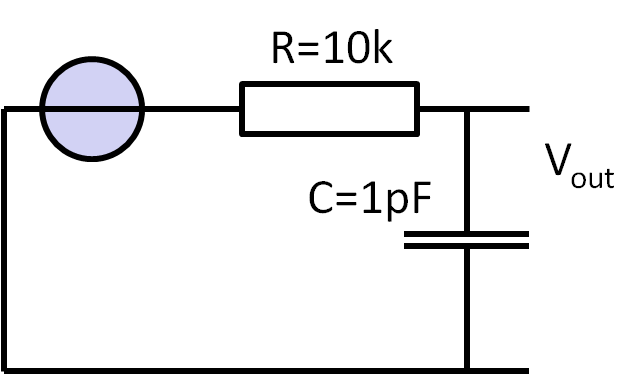
|
Elektronik 3: 24 Rauschen
RC low pass thermal noise capacitance requirement
|
\( C \gt 12 \cdot k_B \cdot T \frac{2^{2 B}}{V_{FS}^{2}} \) kB: Boltzmann constant T: absolute temperature in Kelvin B: number of Bits VFS: Full scale voltage
|
\( \sqrt{\frac{k_B T}{C}} = \sqrt{\frac{V_{FS}^2}{2^{2B} \cdot 12}}\)
|
Decreasing the voltage by a factor of 3.3 increases the capacitance with a factor of 10.
3 Bit R string or ladder DAC
|
A R ladder divides VREF voltage into all possible voltage levels. Inherent monotonic Example: Input Code [d2 d1 d0] = 011 LSB = Vref/8 Vout = LSB * (0*4 + 1*2 + 1) = 3/8 Vref |
|
At each resistance there is a LSB voltage difference.
D0b is the inverted signal of D0.
At certain code all "1" signals close the associated switches.
A voltage is transfered to Vout.
The shown circuit can be saved and simulated in LTSPICE giving a ramp test.
D0b is the inverted signal of D0.
At certain code all "1" signals close the associated switches.
A voltage is transfered to Vout.
The shown circuit can be saved and simulated in LTSPICE giving a ramp test.
3 Bit R string or ladder DAC
SpeedTime constant:Ideal voltage source at a series RC low pass. R = (3 R || 5 R) = 15/8 R Maximum resistance for half VDD, code 100... PowerStatic\( P_{RS} = \frac{V_{ref}^2}{R \cdot 2^{B}} \) Number of bitsResistance range:1 Ω .. 1 MΩ 20 bits. Resistance for MOSFET switches and contacts. Complexity2B resistors and 2 * 2B switches are a high element count |
τ = 0.25 · 2B R C
There are 2B of unit resistors.
The highest resistance is at midpoint. Half resistance will be connected to VDD and half to ground.
For equivalent resistance these resistances are in parallel.
There are 2B of unit resistors.
The highest resistance is at midpoint. Half resistance will be connected to VDD and half to ground.
For equivalent resistance these resistances are in parallel.
Practical example
M. Pelgrom, “A 10-b 50-MHz CMOS D/A Converter with 75-W Buffer,” JSSC, Dec. 1990, pp. 1347
1 V pp output into 75 Ω, 25 pF load
1.6 µm CMOS, 5 V; 65mW (50 MHz, 1Vpp); 1024 resistors 6..10 Ω
16 large resistors 250 Ω parallel to 32 75 Ω polysilison resistors with switches each;
Power: driver transistor 7.3 mA, driver circuit 4 mA; ladder current 1mA, digital 0.7 mA: total 13mA.
Rise fall time 6ns; 19 Mhz signal bandwidth; 50 MHz sample frequency; 2.5 mm2 die size
DNL; INL < 0.35; 5MHz Signal -53 dB to total harmonic distortion
Resolution: 8, 14, 20 bit
Frequency: 10 kHz, 1 MHz, 100 MHz
VDD = VREF = 1V (Integrated Circuits)
Cload = 10 pF (oscilloscope)
4 Bit interpolating R string, ladder DAC
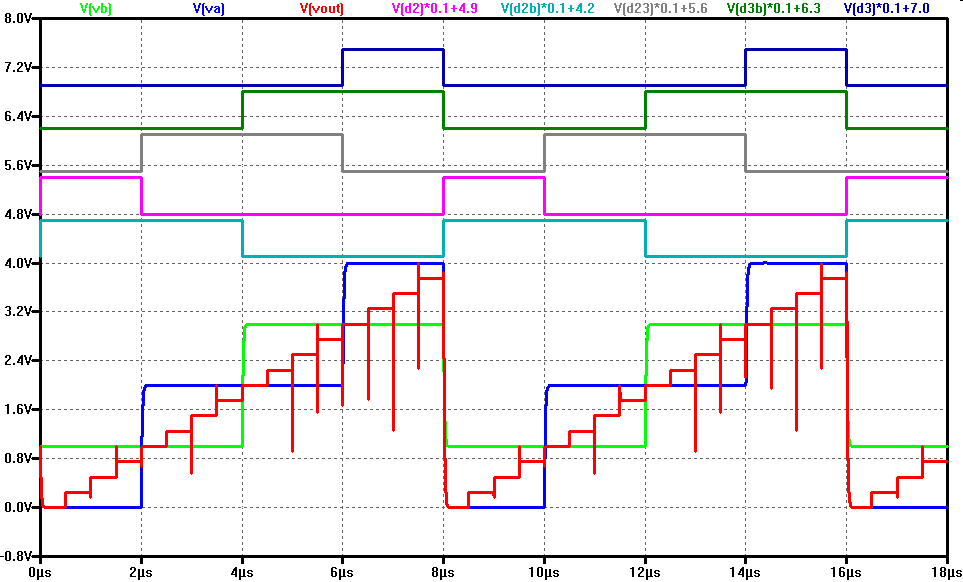
|
Extra logic is needed to generate the control signals from the binary input code.
2 switches are always active on the left side for the 2 high order bits providing an upper and lower voltage for interpolation.
The simulation shows the control signals for the upper bits, the intermediate voltages VA and VB and the resulting output voltage Vout.
2 switches are always active on the left side for the 2 high order bits providing an upper and lower voltage for interpolation.
The simulation shows the control signals for the upper bits, the intermediate voltages VA and VB and the resulting output voltage Vout.
| MSB DA3 | DA2 | DA1 | LSB DA0 |
D3 | D3b | D23 | D2b | D2 | D1 | D1b | D01 | D0 | D0B | VA/V | VB/V |
| 0 | 0 | 0 | 0 | 0 | 0 | 0 | 1 | 1 | 1 | 0 | 0 | 0 | 1 | 0 | 1 |
3 Bit binary charge scaling DAC
|
Each capacitor is binary weighted. \( V_{max} = V_{ref} \) Using equivalent current sources: \( \underline{I}_{Di} = \underline{V}_{ref} \cdot j ω C_{i} \) \( V(D2D1D0)= V_{ref} \frac{D2 \cdot C_{2} + D1 \cdot C_{1} + D0 \cdot C_{0} }{C_{Total}} \) \( C_{Total} = \sum_{i=0}^N C_{i} \) |
Therefore reset switches are needed after each cycle.
Alternatively a code of all 0 can be applied between data output.
This causes additional power consumption.
4 Bit binary split array charge DAC
|
The range of C can be limited using a coupling capacitor C4. |
R2R DAC
|
Only R and 2R values are needed. |
Calculation of output voltage with equivalent sources:
R is 1 kΩ.
All data inputs can be looked at as voltage sources VD0...VD3.
The voltages internally for equivalent sources are V0L..V2L, VoutL.
\( V_{0L} = V_{D0} \frac{2 R}{4 R} = V_{D0} \frac{1}{2} \)
\( R_{i0} = 2 R || 2R = \frac{2 R 2 R}{2 R + 2 R} = R \)
\( V_{1L} = (V_{0L} - V_{D1}) \frac{2 R}{4 R} + V_{D1} = V_{0L} \frac{1}{2} + V_{D1} \frac{1}{2} = V_{D0} \frac{1}{4} + V_{D1} \frac{1}{2}\)
\( R_{i1} = 2 R || 2R = \frac{2 R 2 R}{2 R + 2 R} = R \)
\( V_{nL} = (V_{(n-1)L} - V_{Dn}) \frac{2 R}{4 R} + V_{Dn} = V_{(n-1)L} \frac{1}{2} + V_{Dn} \frac{1}{2} = \sum_{i=0}^{n} \frac{V_{Di}}{2^{n-i+1}} \)
Capacitors can be used instead of the resistance R giving a C2C DAC.
R is 1 kΩ.
All data inputs can be looked at as voltage sources VD0...VD3.
The voltages internally for equivalent sources are V0L..V2L, VoutL.
\( V_{0L} = V_{D0} \frac{2 R}{4 R} = V_{D0} \frac{1}{2} \)
\( R_{i0} = 2 R || 2R = \frac{2 R 2 R}{2 R + 2 R} = R \)
\( V_{1L} = (V_{0L} - V_{D1}) \frac{2 R}{4 R} + V_{D1} = V_{0L} \frac{1}{2} + V_{D1} \frac{1}{2} = V_{D0} \frac{1}{4} + V_{D1} \frac{1}{2}\)
\( R_{i1} = 2 R || 2R = \frac{2 R 2 R}{2 R + 2 R} = R \)
\( V_{nL} = (V_{(n-1)L} - V_{Dn}) \frac{2 R}{4 R} + V_{Dn} = V_{(n-1)L} \frac{1}{2} + V_{Dn} \frac{1}{2} = \sum_{i=0}^{n} \frac{V_{Di}}{2^{n-i+1}} \)
Capacitors can be used instead of the resistance R giving a C2C DAC.
Practical considerations
|
Variations of components: R, C, V offset of operational amplifier What is allowed to have less than 1/2 LSB INL and DNL? |
Low Cost Serial C DAC Circuit
|
Simulation schematic LTSPICE Minimum number of parts Number of cycles gives the resolution Low cost Arduino MKR WIFI1010 TLC272 ALD1106, ALD1107 3x C=20nF Breadboard Study DAC simulation, measurement, errors and error correction |
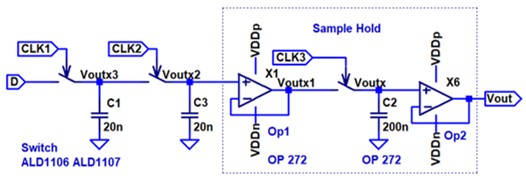 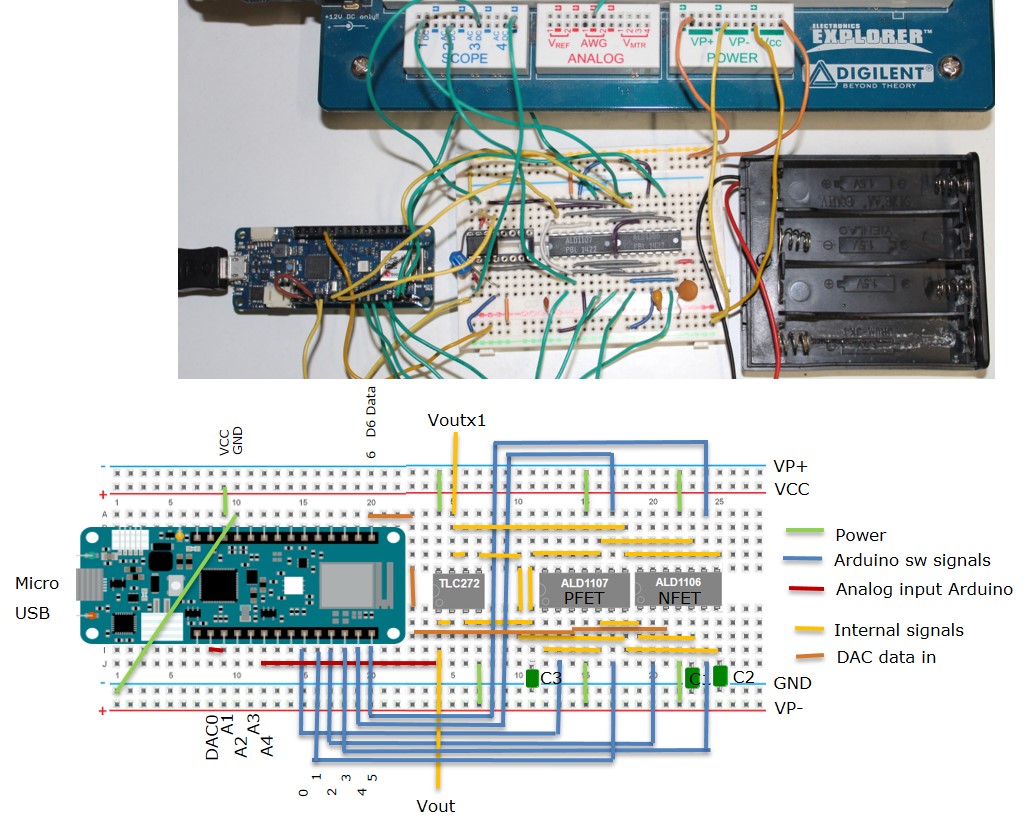 |
\( Voutx2(n+1) = \frac{Voutx2(n) + Voutx3}{2}
= \frac{Voutx2(n) + VDD \cdot D(n)}{2} \)
\( Voutx2(n+1) = VDD \cdot (0.25 \cdot Voutx2(n-1) + 0.25 \cdot D(n-1) + 0.5 \cdot D(n) \)
\( Vout = \sum_{k=0}^{nBit-1} 2^{-nBit+k} D(k) \)
Vollrath, "Low cost serial DAC", MPC Workshop, 2024
\( Voutx2(n+1) = VDD \cdot (0.25 \cdot Voutx2(n-1) + 0.25 \cdot D(n-1) + 0.5 \cdot D(n) \)
\( Vout = \sum_{k=0}^{nBit-1} 2^{-nBit+k} D(k) \)
Vollrath, "Low cost serial DAC", MPC Workshop, 2024
References
C. Lin and K. Buit, " A 10-b, 500- MSample/s CMOS DAC in 0.6mm2", JSSC, vol. 33, pp.1948-1958,1998Untrimmed segmented
T. Miki et al, “An 80-MHz 8-bit CMOS D/A Converter,” JSSC December 1986, pp. 983
A. Van den Bosch et al, “A 1-GSample/s Nyquist Current-Steering CMOS D/A Converter,” JSSC March 2001, pp. 315 Savoj, J, A 12-GS/s Phase-Calibrated CMOS Digital-to-Analog Converter for Backplane Communications , JSSC, 2008, pp. 1207 - 1216
Current copiers:
D. W. J. Groeneveld et al, “A Self-Calibration Technique for Monolithic High-Resolution D/A Converters,” JSSC December 1989, pp. 1517
Dynamic element matching:
R. J. van de Plassche, “Dynamic Element Matching for High-Accuracy Monolithic D/A Converters,” JSSC December 1976, pp. 795